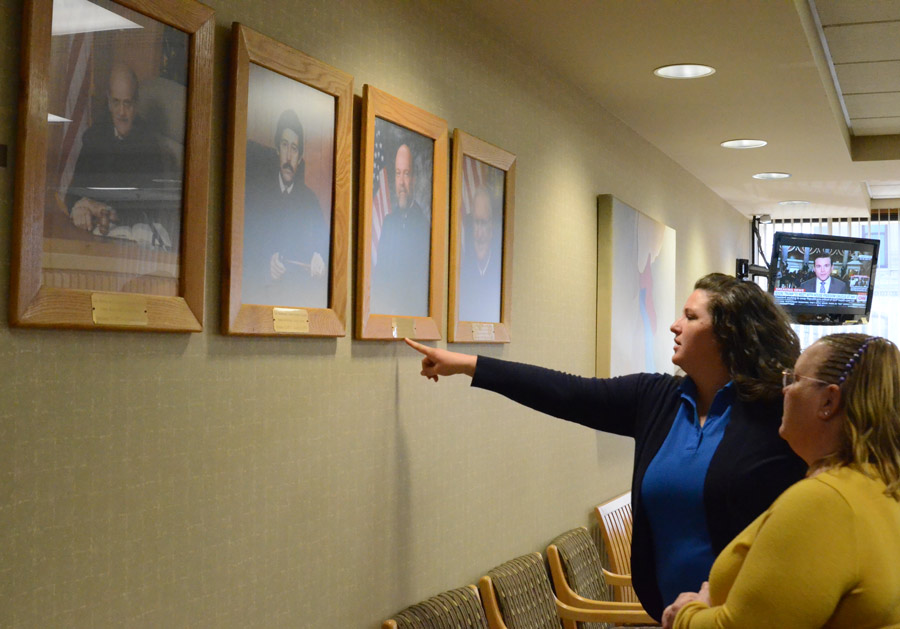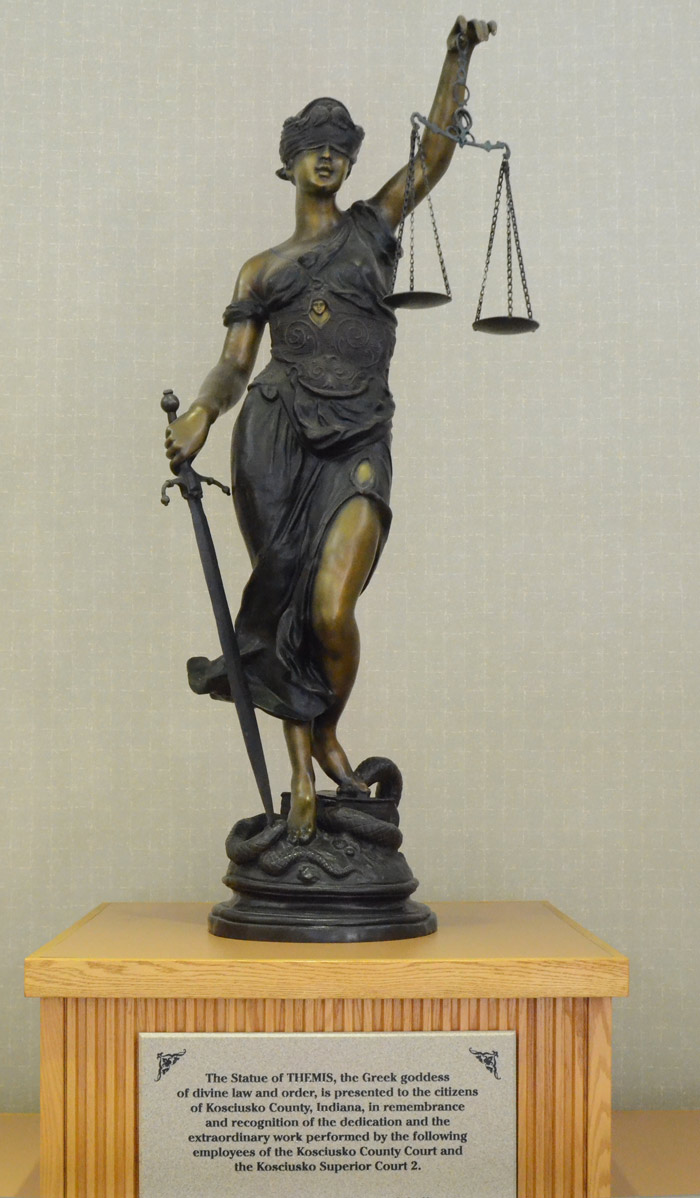
Janelle Meyer and Aimee Kintzel look at the four portraits of the judges who have served on the bench since the start of county court in late 1975 and later became Superior Court 2 and Superior Court 3. Like many courthouses, these photos have been placed in the lobby to reflect the history of that court. (Photo by Deb Patterson)
WARSAW — Efforts to preserve the history of judicial service can be seen in many courthouses. Portraits of judges with plaques noting the years served on the bench can be found hanging on the walls near the courts.
Such efforts have begun in Kosciusko County. Portraits of four individuals who have served as judges in Kosciusko County Court, which later became Kosciusko Superior 2 and Superior 3, are displayed in the waiting area on the second floor.
The photos are of judges: Bob Burner, Dec. 23, 1975-Dec. 13, 1977; Loren Collier, Oct. 13, 1977-Aug. 10, 1979; Byron Tinkey, Jan. 4, 1988 to Dec. 31, 1996; and James Jarrette, Sept. 4, 1979, to Dec. 31, 2014.

The statute of Themis, the Greek goddess of divine law and order, can be found at the top of the stairs in the Kosciusko County Justice Building. This statute remembers and recognizes the work performed by employees of Kosciusko County Court and Kosciusko Superior Court 2. Information on each individual along with photographs are enclosed in the wooden pedestal with their names engraved on the plaque in front. This is another means to preserve history of the court. (Photo by Deb Patterson)
Recognition of these judges was the idea of one person, who wishes to remain anonymous. The decision was made to begin with the former county court as its history was the shortest and easiest to track the judges.
Photographs of the judges were obtained and enlarged. Discarded pallets, made from oak, were salvaged and more than 12 frames made. All expenses for the framed photographs were paid for by the person who wanted to preserve the legacy of these judges. No county funds were used.
Sealed behind the photograph is a brief personal biography of the judge, written by either family members or the judge.
The county commissioners were approached for permission to display these photos in the Justice Building. Noting it was important for the county’s history to remember and record those who served, permission was given to allow the photos to be hung in the public area of the Justice Building.
Ron Truex, county commissioner, stated “I thought it would be an appropriate thing to do,” when he was approached about the idea and talking with the two other commissioners. “It should be done for the county. History’s great. How else are people going to know 20 years from now?” Truex also agrees something should be done for the other courts.
The county court was started in 1975 with Burner. He served until a vacancy occurred in superior court. Burner was followed by Collier who was appointed by Gov. Otis Bowen to fill the seat. Following Collier was Jarrette who sat on the bench until retirement in 2014.
It was during Jarrette’s term legislation allowed the county courts to have a referee to help handle the case loads. Tinkey was appointed. Tinkey would preside over the small claims cases, make a recommendation to Jarrette, who signed the recommendations. Soon county court was renamed Superior 2 and Superior 3 was created. Now these courts were no longer limited to traffic and small claims. Superior 3 came about to help with the case load. Judge Joe Sutton then took over for Tinkey.
The hope is to add the photograph of each judge when he leaves the bench. Sutton and Torey Bauer will be the next two added to the wall of judges.
However, several questions still are unanswered. The county commissioners have control of the building, but will the tradition that has begun be continued? Is there interest to tackle the history of circuit and superior court judges? Are there photos available of judges from the two courts with the longest history?
Sally Hogan, Kosciusko Historical Society executive director, is pleased with what has begun as it “preserves our history.” She noted there is a gap in the history of the county’s judges. Not a lot is known about who these judges were, how the courts developed and advanced. There are also a lack of photographs of past judges in the circuit and superior courts.


















